Financial Analysis of Transurban: BUACC 5930, Semester 1, 2019
VerifiedAdded on 2022/11/26
|7
|1239
|189
Report
AI Summary
This report presents a comprehensive financial analysis of Transurban, a company primarily involved in building toll roads. The analysis focuses on comparing the company's financial results between 2017 and 2018, utilizing ratio analysis to assess profitability, liquidity, efficiency, and gearing ratios. The report interprets the trends observed in these ratios, highlighting areas of improvement and concern, such as the decline in gross profit margin and the fluctuations in interest coverage ratio. It also explores Transurban's initiatives in meeting the UN Sustainable Development Goals (SDGs), providing an opinion on these initiatives. Furthermore, the report discusses the need for additional information, such as industry ratios and macroeconomic factors, to gain a more complete understanding of Transurban's financial position. The analysis is based on the provided annual reports and supplementary materials.
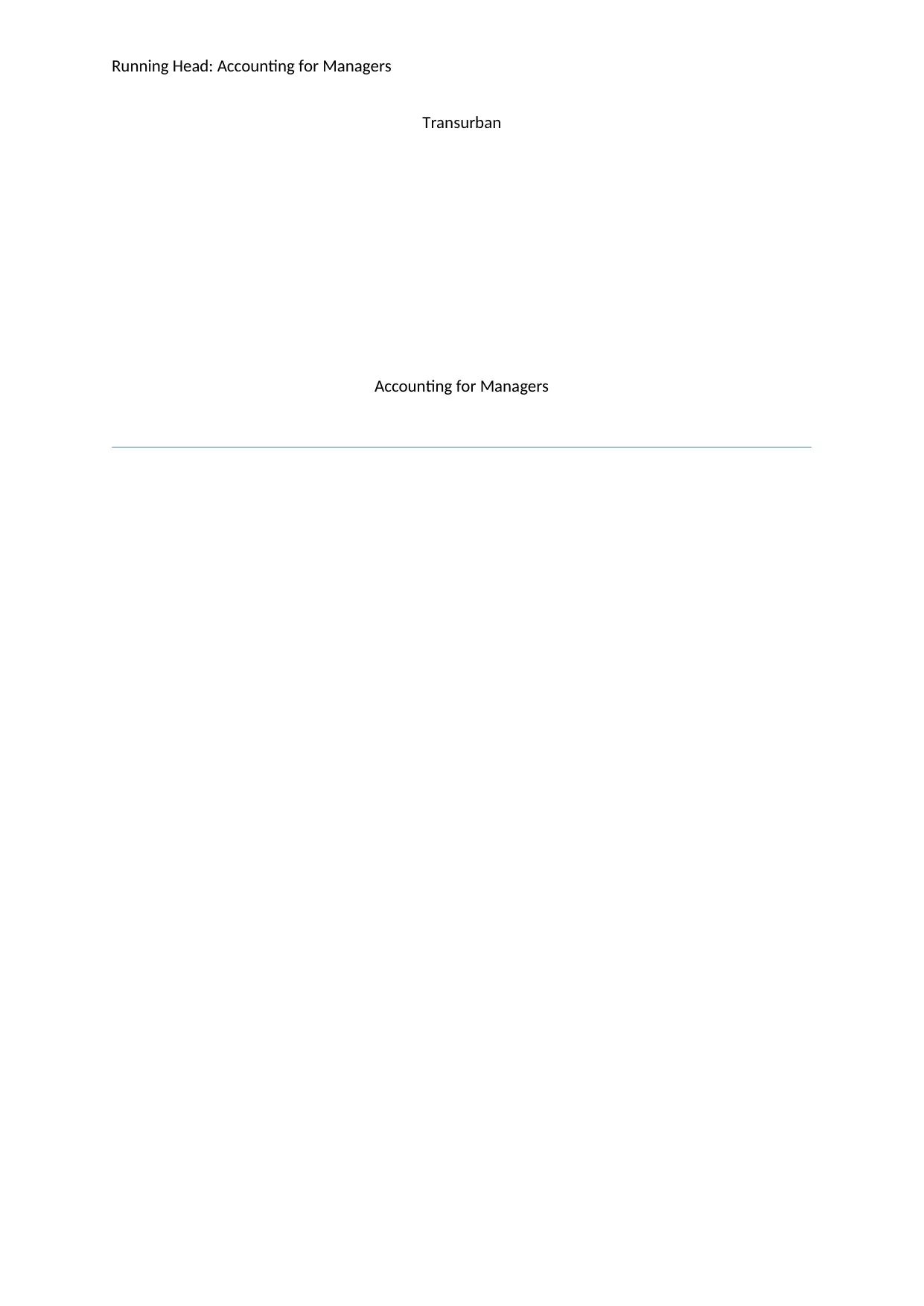
Running Head: Accounting for Managers
Transurban
Accounting for Managers
Transurban
Accounting for Managers
Paraphrase This Document
Need a fresh take? Get an instant paraphrase of this document with our AI Paraphraser
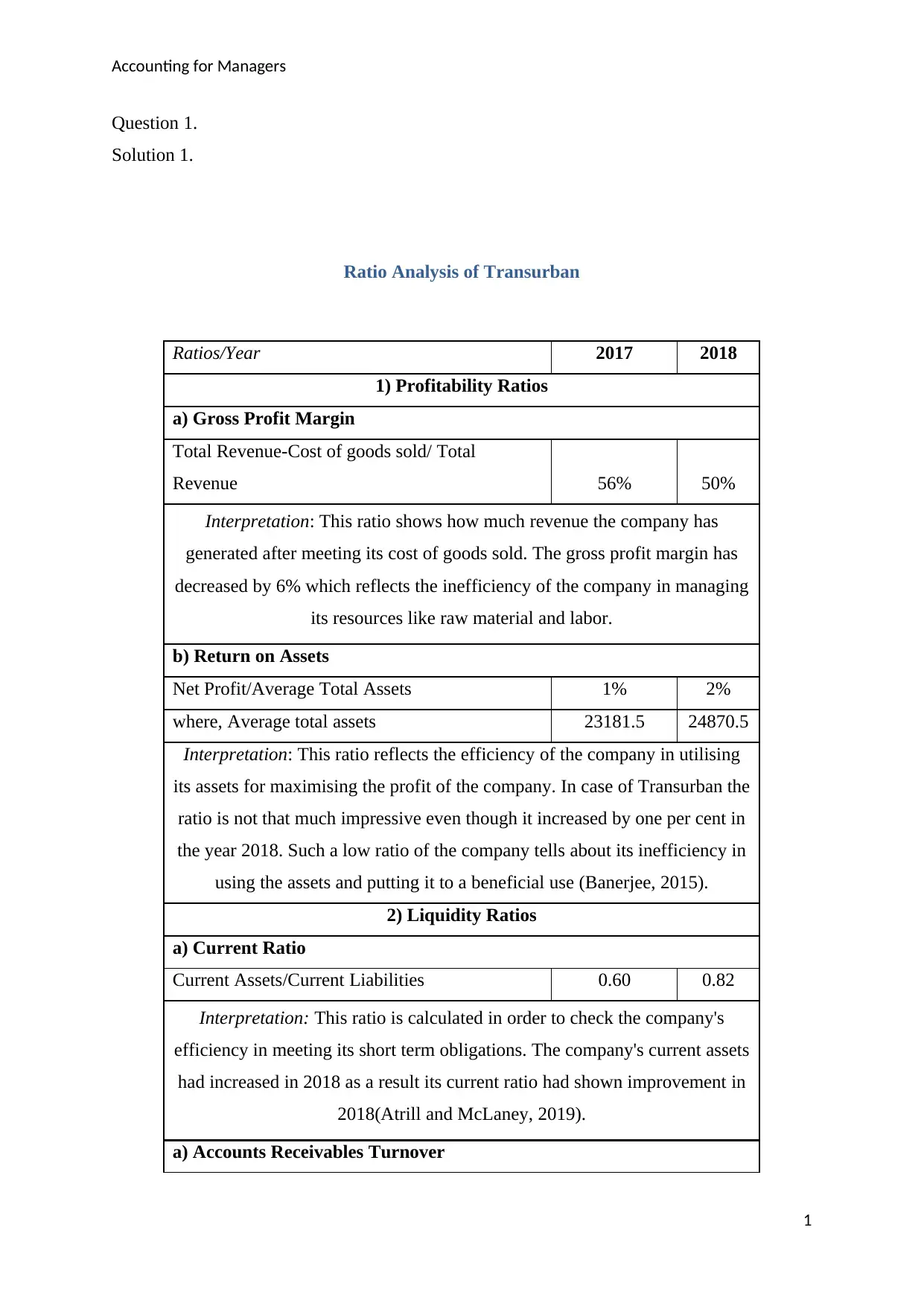
Accounting for Managers
Question 1.
Solution 1.
Ratio Analysis of Transurban
Ratios/Year 2017 2018
1) Profitability Ratios
a) Gross Profit Margin
Total Revenue-Cost of goods sold/ Total
Revenue 56% 50%
Interpretation: This ratio shows how much revenue the company has
generated after meeting its cost of goods sold. The gross profit margin has
decreased by 6% which reflects the inefficiency of the company in managing
its resources like raw material and labor.
b) Return on Assets
Net Profit/Average Total Assets 1% 2%
where, Average total assets 23181.5 24870.5
Interpretation: This ratio reflects the efficiency of the company in utilising
its assets for maximising the profit of the company. In case of Transurban the
ratio is not that much impressive even though it increased by one per cent in
the year 2018. Such a low ratio of the company tells about its inefficiency in
using the assets and putting it to a beneficial use (Banerjee, 2015).
2) Liquidity Ratios
a) Current Ratio
Current Assets/Current Liabilities 0.60 0.82
Interpretation: This ratio is calculated in order to check the company's
efficiency in meeting its short term obligations. The company's current assets
had increased in 2018 as a result its current ratio had shown improvement in
2018(Atrill and McLaney, 2019).
a) Accounts Receivables Turnover
1
Question 1.
Solution 1.
Ratio Analysis of Transurban
Ratios/Year 2017 2018
1) Profitability Ratios
a) Gross Profit Margin
Total Revenue-Cost of goods sold/ Total
Revenue 56% 50%
Interpretation: This ratio shows how much revenue the company has
generated after meeting its cost of goods sold. The gross profit margin has
decreased by 6% which reflects the inefficiency of the company in managing
its resources like raw material and labor.
b) Return on Assets
Net Profit/Average Total Assets 1% 2%
where, Average total assets 23181.5 24870.5
Interpretation: This ratio reflects the efficiency of the company in utilising
its assets for maximising the profit of the company. In case of Transurban the
ratio is not that much impressive even though it increased by one per cent in
the year 2018. Such a low ratio of the company tells about its inefficiency in
using the assets and putting it to a beneficial use (Banerjee, 2015).
2) Liquidity Ratios
a) Current Ratio
Current Assets/Current Liabilities 0.60 0.82
Interpretation: This ratio is calculated in order to check the company's
efficiency in meeting its short term obligations. The company's current assets
had increased in 2018 as a result its current ratio had shown improvement in
2018(Atrill and McLaney, 2019).
a) Accounts Receivables Turnover
1
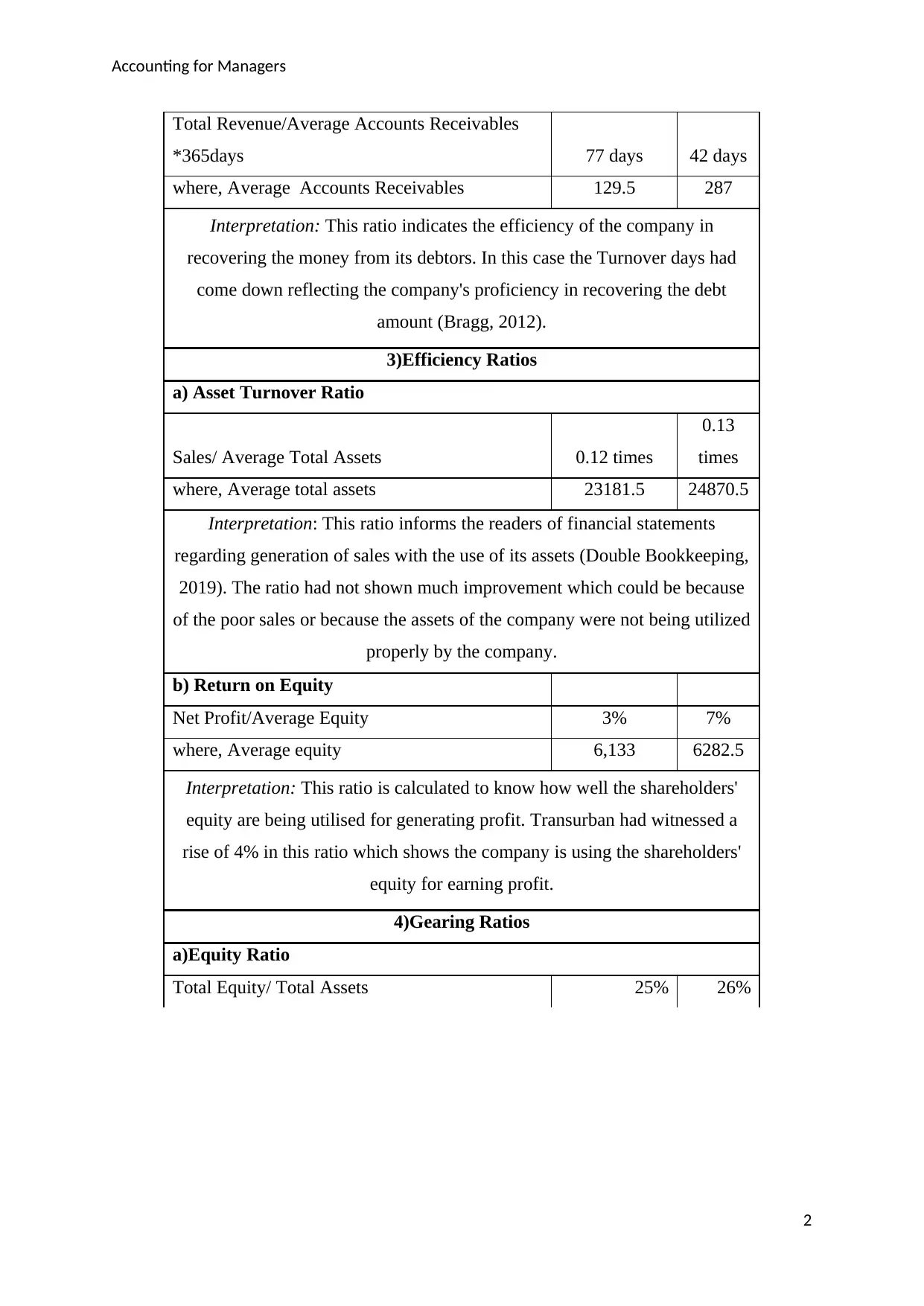
Accounting for Managers
Total Revenue/Average Accounts Receivables
*365days 77 days 42 days
where, Average Accounts Receivables 129.5 287
Interpretation: This ratio indicates the efficiency of the company in
recovering the money from its debtors. In this case the Turnover days had
come down reflecting the company's proficiency in recovering the debt
amount (Bragg, 2012).
3)Efficiency Ratios
a) Asset Turnover Ratio
Sales/ Average Total Assets 0.12 times
0.13
times
where, Average total assets 23181.5 24870.5
Interpretation: This ratio informs the readers of financial statements
regarding generation of sales with the use of its assets (Double Bookkeeping,
2019). The ratio had not shown much improvement which could be because
of the poor sales or because the assets of the company were not being utilized
properly by the company.
b) Return on Equity
Net Profit/Average Equity 3% 7%
where, Average equity 6,133 6282.5
Interpretation: This ratio is calculated to know how well the shareholders'
equity are being utilised for generating profit. Transurban had witnessed a
rise of 4% in this ratio which shows the company is using the shareholders'
equity for earning profit.
4)Gearing Ratios
a)Equity Ratio
Total Equity/ Total Assets 25% 26%
2
Total Revenue/Average Accounts Receivables
*365days 77 days 42 days
where, Average Accounts Receivables 129.5 287
Interpretation: This ratio indicates the efficiency of the company in
recovering the money from its debtors. In this case the Turnover days had
come down reflecting the company's proficiency in recovering the debt
amount (Bragg, 2012).
3)Efficiency Ratios
a) Asset Turnover Ratio
Sales/ Average Total Assets 0.12 times
0.13
times
where, Average total assets 23181.5 24870.5
Interpretation: This ratio informs the readers of financial statements
regarding generation of sales with the use of its assets (Double Bookkeeping,
2019). The ratio had not shown much improvement which could be because
of the poor sales or because the assets of the company were not being utilized
properly by the company.
b) Return on Equity
Net Profit/Average Equity 3% 7%
where, Average equity 6,133 6282.5
Interpretation: This ratio is calculated to know how well the shareholders'
equity are being utilised for generating profit. Transurban had witnessed a
rise of 4% in this ratio which shows the company is using the shareholders'
equity for earning profit.
4)Gearing Ratios
a)Equity Ratio
Total Equity/ Total Assets 25% 26%
2
⊘ This is a preview!⊘
Do you want full access?
Subscribe today to unlock all pages.

Trusted by 1+ million students worldwide
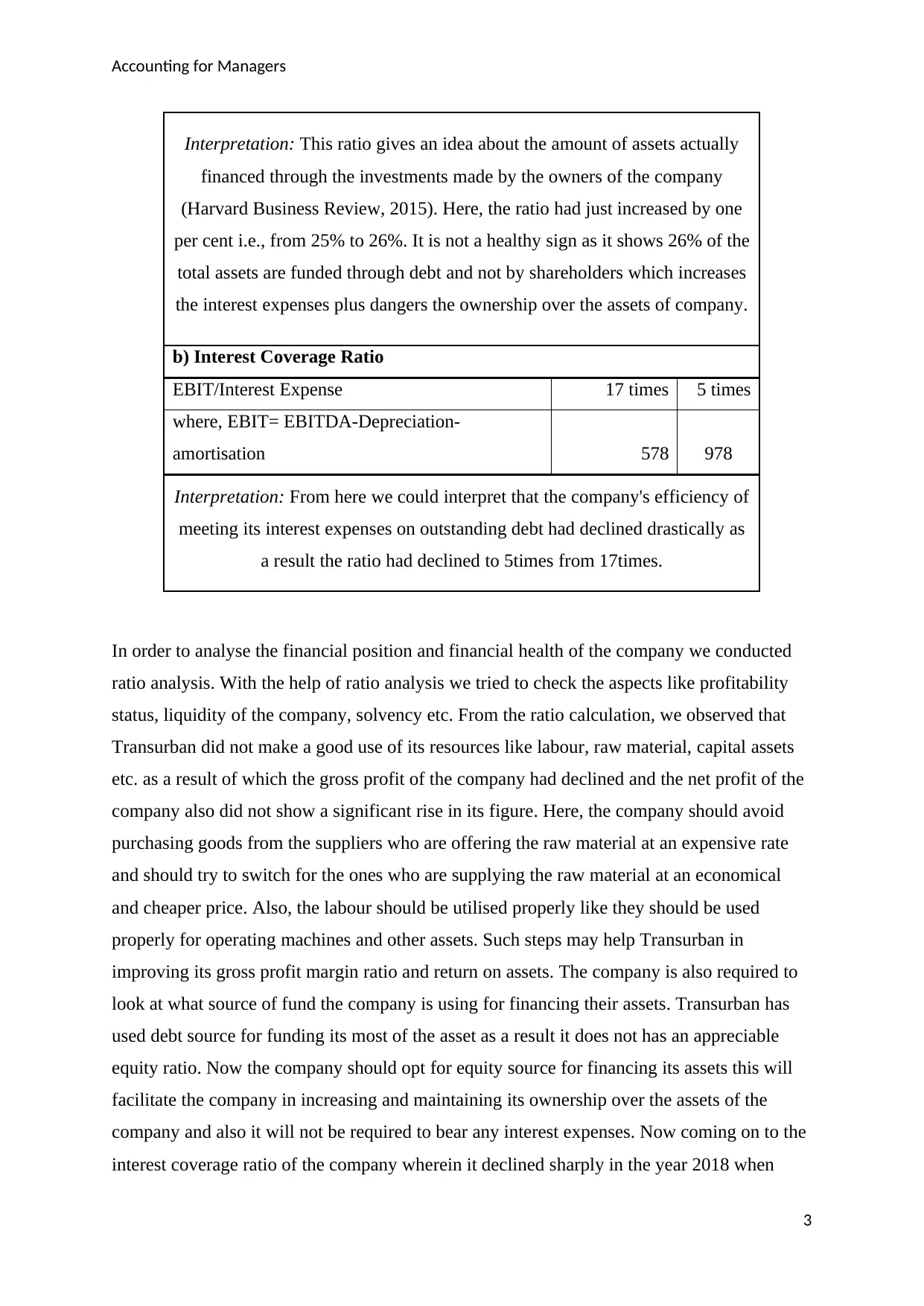
Accounting for Managers
Interpretation: This ratio gives an idea about the amount of assets actually
financed through the investments made by the owners of the company
(Harvard Business Review, 2015). Here, the ratio had just increased by one
per cent i.e., from 25% to 26%. It is not a healthy sign as it shows 26% of the
total assets are funded through debt and not by shareholders which increases
the interest expenses plus dangers the ownership over the assets of company.
b) Interest Coverage Ratio
EBIT/Interest Expense 17 times 5 times
where, EBIT= EBITDA-Depreciation-
amortisation 578 978
Interpretation: From here we could interpret that the company's efficiency of
meeting its interest expenses on outstanding debt had declined drastically as
a result the ratio had declined to 5times from 17times.
In order to analyse the financial position and financial health of the company we conducted
ratio analysis. With the help of ratio analysis we tried to check the aspects like profitability
status, liquidity of the company, solvency etc. From the ratio calculation, we observed that
Transurban did not make a good use of its resources like labour, raw material, capital assets
etc. as a result of which the gross profit of the company had declined and the net profit of the
company also did not show a significant rise in its figure. Here, the company should avoid
purchasing goods from the suppliers who are offering the raw material at an expensive rate
and should try to switch for the ones who are supplying the raw material at an economical
and cheaper price. Also, the labour should be utilised properly like they should be used
properly for operating machines and other assets. Such steps may help Transurban in
improving its gross profit margin ratio and return on assets. The company is also required to
look at what source of fund the company is using for financing their assets. Transurban has
used debt source for funding its most of the asset as a result it does not has an appreciable
equity ratio. Now the company should opt for equity source for financing its assets this will
facilitate the company in increasing and maintaining its ownership over the assets of the
company and also it will not be required to bear any interest expenses. Now coming on to the
interest coverage ratio of the company wherein it declined sharply in the year 2018 when
3
Interpretation: This ratio gives an idea about the amount of assets actually
financed through the investments made by the owners of the company
(Harvard Business Review, 2015). Here, the ratio had just increased by one
per cent i.e., from 25% to 26%. It is not a healthy sign as it shows 26% of the
total assets are funded through debt and not by shareholders which increases
the interest expenses plus dangers the ownership over the assets of company.
b) Interest Coverage Ratio
EBIT/Interest Expense 17 times 5 times
where, EBIT= EBITDA-Depreciation-
amortisation 578 978
Interpretation: From here we could interpret that the company's efficiency of
meeting its interest expenses on outstanding debt had declined drastically as
a result the ratio had declined to 5times from 17times.
In order to analyse the financial position and financial health of the company we conducted
ratio analysis. With the help of ratio analysis we tried to check the aspects like profitability
status, liquidity of the company, solvency etc. From the ratio calculation, we observed that
Transurban did not make a good use of its resources like labour, raw material, capital assets
etc. as a result of which the gross profit of the company had declined and the net profit of the
company also did not show a significant rise in its figure. Here, the company should avoid
purchasing goods from the suppliers who are offering the raw material at an expensive rate
and should try to switch for the ones who are supplying the raw material at an economical
and cheaper price. Also, the labour should be utilised properly like they should be used
properly for operating machines and other assets. Such steps may help Transurban in
improving its gross profit margin ratio and return on assets. The company is also required to
look at what source of fund the company is using for financing their assets. Transurban has
used debt source for funding its most of the asset as a result it does not has an appreciable
equity ratio. Now the company should opt for equity source for financing its assets this will
facilitate the company in increasing and maintaining its ownership over the assets of the
company and also it will not be required to bear any interest expenses. Now coming on to the
interest coverage ratio of the company wherein it declined sharply in the year 2018 when
3
Paraphrase This Document
Need a fresh take? Get an instant paraphrase of this document with our AI Paraphraser
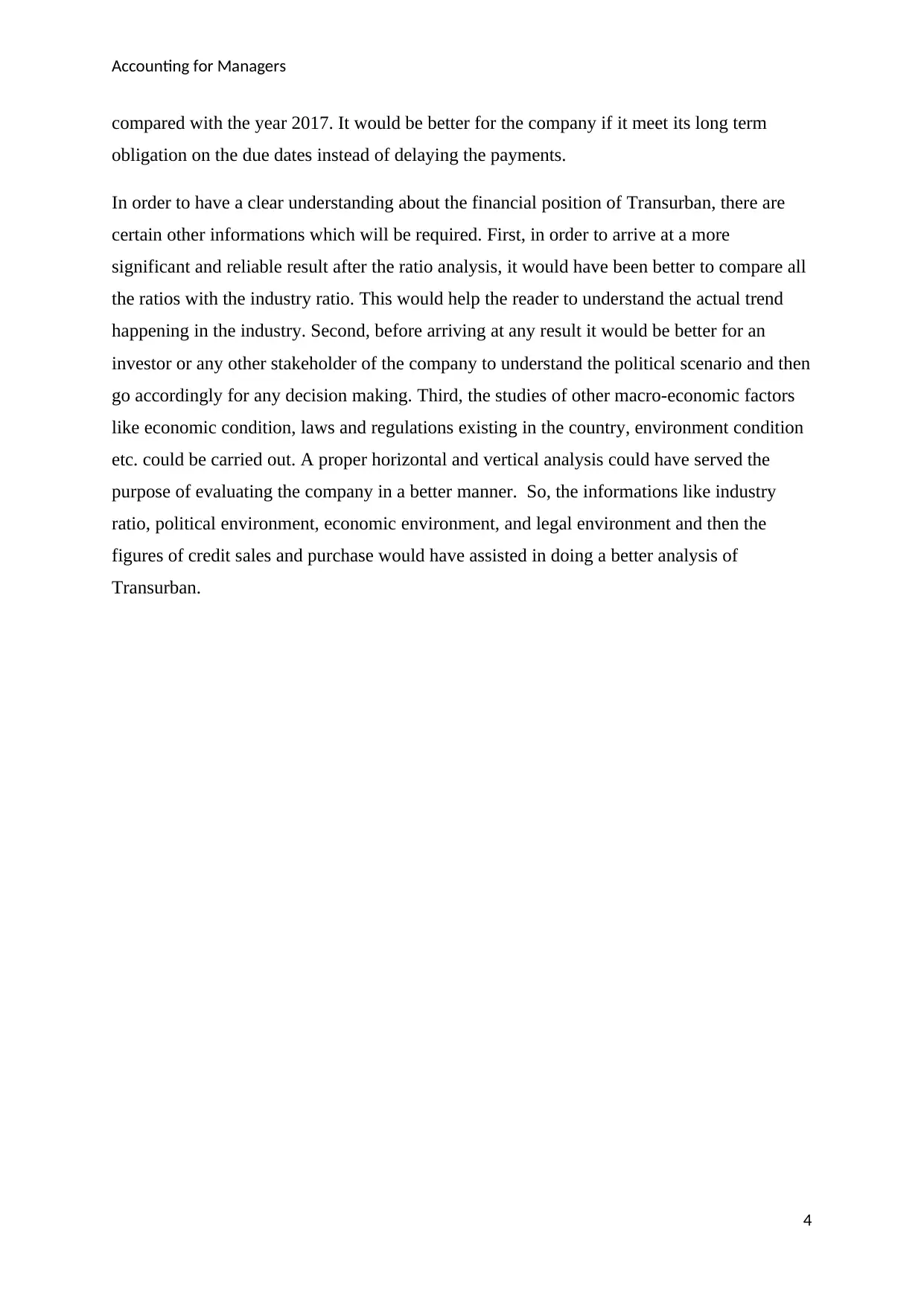
Accounting for Managers
compared with the year 2017. It would be better for the company if it meet its long term
obligation on the due dates instead of delaying the payments.
In order to have a clear understanding about the financial position of Transurban, there are
certain other informations which will be required. First, in order to arrive at a more
significant and reliable result after the ratio analysis, it would have been better to compare all
the ratios with the industry ratio. This would help the reader to understand the actual trend
happening in the industry. Second, before arriving at any result it would be better for an
investor or any other stakeholder of the company to understand the political scenario and then
go accordingly for any decision making. Third, the studies of other macro-economic factors
like economic condition, laws and regulations existing in the country, environment condition
etc. could be carried out. A proper horizontal and vertical analysis could have served the
purpose of evaluating the company in a better manner. So, the informations like industry
ratio, political environment, economic environment, and legal environment and then the
figures of credit sales and purchase would have assisted in doing a better analysis of
Transurban.
4
compared with the year 2017. It would be better for the company if it meet its long term
obligation on the due dates instead of delaying the payments.
In order to have a clear understanding about the financial position of Transurban, there are
certain other informations which will be required. First, in order to arrive at a more
significant and reliable result after the ratio analysis, it would have been better to compare all
the ratios with the industry ratio. This would help the reader to understand the actual trend
happening in the industry. Second, before arriving at any result it would be better for an
investor or any other stakeholder of the company to understand the political scenario and then
go accordingly for any decision making. Third, the studies of other macro-economic factors
like economic condition, laws and regulations existing in the country, environment condition
etc. could be carried out. A proper horizontal and vertical analysis could have served the
purpose of evaluating the company in a better manner. So, the informations like industry
ratio, political environment, economic environment, and legal environment and then the
figures of credit sales and purchase would have assisted in doing a better analysis of
Transurban.
4

Accounting for Managers
References
Atrill, P. & McLaney, E. (2019). Accounting and Finance for Non-Specialists. 11th ed.
Harlow: Pearson.
Banerjee, B. 2015. Fundamentals of financial management. Delhi: PHI Learning.
Bragg, S. M. (2012). Business Ratios and Formulas: A Comprehensive Guide. John Wiley &
Sons: New Jersey.
Double Entry Bookkeeping, 2019. Asset Turnover Ratio. Available at 19th May, 2019
https://www.double-entry-bookkeeping.com/efficiency-ratios/asset-turnover-ratio/.
Harvard Business Review, 2015. A Refresher on Debt-to-Equity Ratio. Available at 19th
May, 2019 https://hbr.org/2015/07/a-refresher-on-debt-to-equity-ratio.
5
References
Atrill, P. & McLaney, E. (2019). Accounting and Finance for Non-Specialists. 11th ed.
Harlow: Pearson.
Banerjee, B. 2015. Fundamentals of financial management. Delhi: PHI Learning.
Bragg, S. M. (2012). Business Ratios and Formulas: A Comprehensive Guide. John Wiley &
Sons: New Jersey.
Double Entry Bookkeeping, 2019. Asset Turnover Ratio. Available at 19th May, 2019
https://www.double-entry-bookkeeping.com/efficiency-ratios/asset-turnover-ratio/.
Harvard Business Review, 2015. A Refresher on Debt-to-Equity Ratio. Available at 19th
May, 2019 https://hbr.org/2015/07/a-refresher-on-debt-to-equity-ratio.
5
⊘ This is a preview!⊘
Do you want full access?
Subscribe today to unlock all pages.

Trusted by 1+ million students worldwide
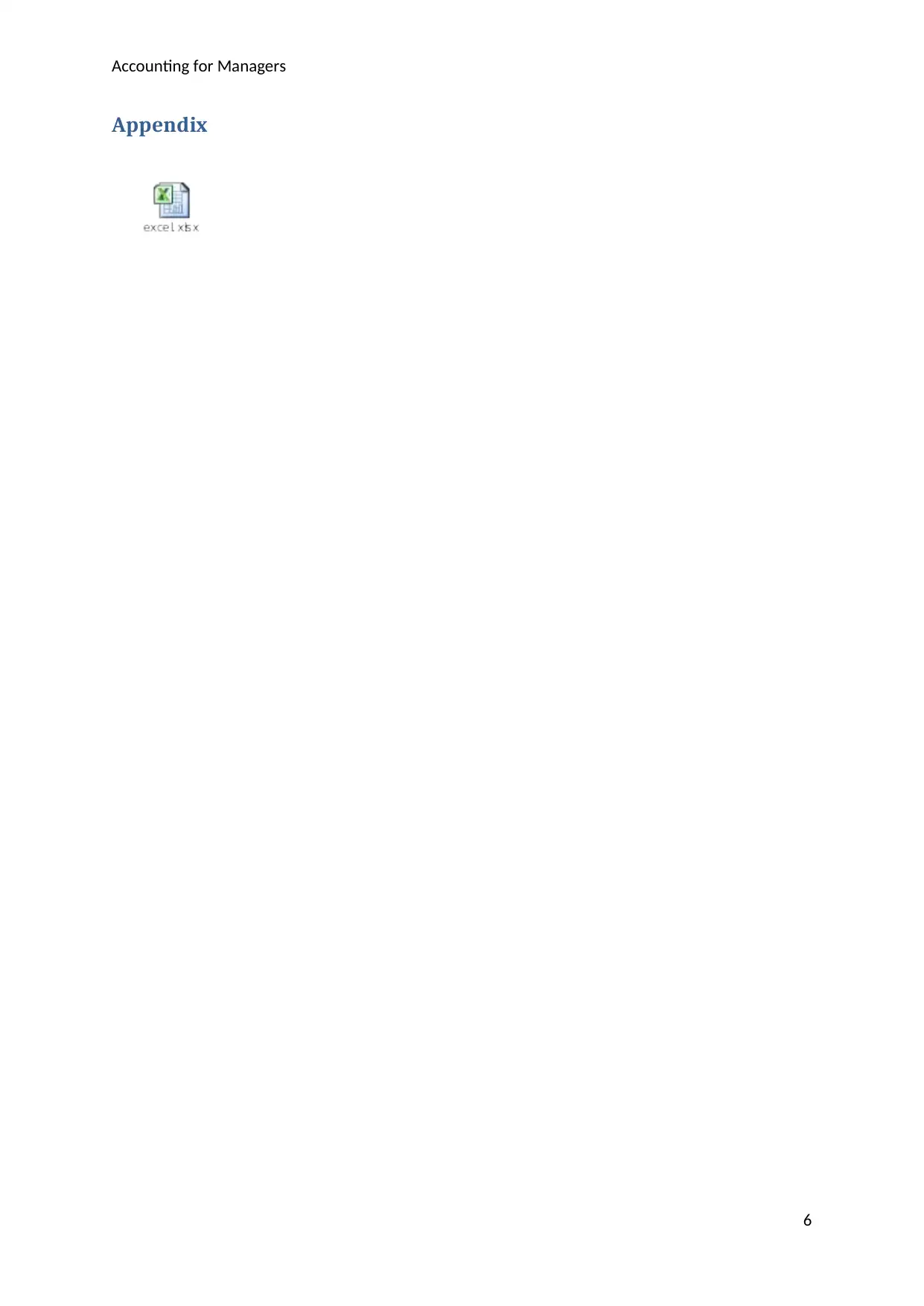
Accounting for Managers
Appendix
6
Appendix
6
1 out of 7
Related Documents
Your All-in-One AI-Powered Toolkit for Academic Success.
+13062052269
info@desklib.com
Available 24*7 on WhatsApp / Email
![[object Object]](/_next/static/media/star-bottom.7253800d.svg)
Unlock your academic potential
Copyright © 2020–2025 A2Z Services. All Rights Reserved. Developed and managed by ZUCOL.




